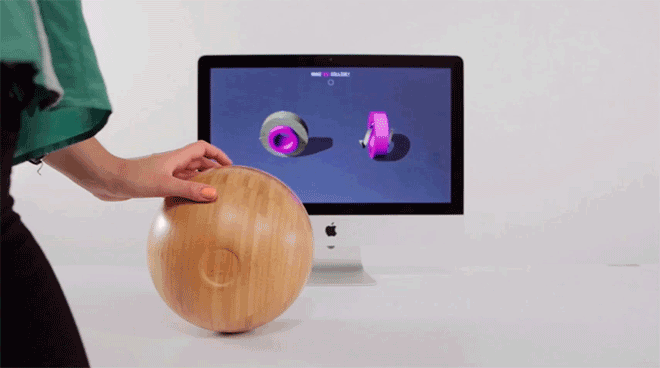Here's a provocative interaction-design thought experiment: What if your iPhone was just, like, a ball.
You wouldn't be able to check Twitter on it, and you wouldn't be able to take selfies with it, but you would be able to roll it around, and if you happened to be playing a videogame that involved rolling a ball around, that actual, physical ball could make for an ideal controller. Well, Marc Dubois made that game. And that ball!
For "OpenControllers," Dubois' degree project at the Swiss school ECAL, the designer created three new game controllers by entombing smartphones inside products from Ikea. It's a reminder that there are interesting ways to interact with our touchscreen playthings beyond simply touching their screens.
The ball controller is really just a phone strapped in place between two wooden bowls. Tapping into readings from the phone's gyroscope, the object functions as a tangible controller for a puzzle game Dubois designed.
It's an elegant solution to a very real problem. At the time, Dubois was doing a lot of 3D work and was interested in the challenge of rotating in three dimensional space. "It's always easy to manage two rotations, but when you want the third, your keyboard misses two more arrows," he says.
A second controller is made of a phone placed face-down inside a translucent cone-shaped lampshade. With the phone's camera watching for light, a player controls a virtual light source in another custom game by shining real-life light on the cone's surface.
In both cases, the relationship between the controller and the thing being controlled is one-to-one. Ball controls ball. Light controls light. Just like swinging a Wiimote to hit a ball in Wii Tennis is more satisfying than using a joystick and buttons to do the same, Dubois' controllers offer a more visceral relationship with the action. They hint at all sorts of possibilities for new mobile games, ones that rely more on our devices' sensors than their screens, all for the price of a sandwich or two (or a few plates of mini meatballs).
But as Dubois points out, the project's also simply a way of demystifying today's devices. "We have so much technology around us, but we are far from understanding how everything works," he says. "In your phone you have too many things: GPS, compass, barometers, gyroscopes, accelerometers, et cetera et cetera. But when they're all inside this block, you don't really know when one or the other is being used."
